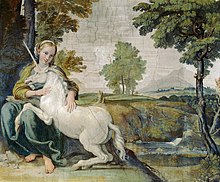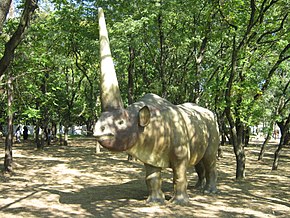Unicorn
 The gentle an pensefu maiden haes the pouer tae tame the unicorn, fresco, probably bi Domenico Zampieri, c. 1602 (Palazzo Farnese, Roum) | |
| Groupin | Meethologie |
|---|---|
| Seemilar craiturs | Pegasus, Qilin, Re'em, Indrik, Shadhavar, Camahueto, Karkadann |
| Meethologie | Worldwide |
| Ither name(s) | Monocerus |
The unicorn is a leegendar ainimal that haes been descrived syne antiquity as a beast wi a lairge, pyntit, spiralin horn projectin frae its foreheid. The unicorn wis depictit in auncient seals o the Indus Valley Ceevilisation an wis mentioned bi the auncient Greeks in accoonts o naitural history bi various writers, includin Ctesias, Strabo, Pliny the Younger, an Aelian.[1] The Bible an aa describes an ainimal, the re'em, that some versions translate as unicorn.[1]
In European fowklair, the unicorn is eften depictit as a white horse-lik or gait-lik ainimal wi a lang horn an cloven huifs (whiles a gait's beard). In the Middle Ages an Renaissance, it wis commonly descrived as an extremely wild widland craitur, a seembol o purity an grace, that coud anly be capturt bi a virgin. In the encyclopaedias its horn wis said tae hae the pouer tae render pushioned watter potable an tae heal sickness. In medieval an Renaissance times, the tusk o the narwhal wis whiles sauld as unicorn horn.
History
[eedit | eedit soorce]In antiquity
[eedit | eedit soorce]
Unicorns are nae foond in Greek meethologie, but raither in the accoonts o naitural history, for Greek writers o naitural history war convinced o the reality o unicorns, that thay believed lived in Indie, a distant an fabulous realm for them. The earliest description is frae Ctesias, that in his beuk Indika ("On Indie") descrived them as wild cuddies, fleet o fit, haein a horn a cubit an a hauf (700 mm, 28 inches) in lenth, an coloured white, reid an black.[2] Aristotle maun be follaein Ctesias whan he mentions twa ane-horned ainimals, the oryx (a kynd o antelope) an the sae-cried "Indie cuddie".[3][4] Strabo says that in the Caucasus thare war ane-horned horse wi stag-lik heids.[5] Pliny the Elder mentions the oryx an an Indian ox (aiblins a rhinoceros) as ane-horned beasts, as weel as "a verra fierce ainimal cried the monoceros that haes the heid o the stag, the feet o the elephant, an the tail o the boar, while the rest o the bouk is lik that o the horse; it maks a deep lawin noise, an haes a single black horn, that projects frae the middle o its foreheid, twa cubits [900 mm, 35 inches] in lenth."[6] In On the Nature of Animals (Περὶ Ζῴων Ἰδιότητος, De natura animalium), Aelian, quotin Ctesias, adds that Indie produces an aa a ane-horned horse (iii. 41; iv. 52),[7][8] an says (xvi. 20)[9] that the monoceros (Greek: μονόκερως) wis whiles cried cartazonos (Greek: καρτάζωνος), that mey be a form o the Arabic karkadann, meanin "rhinoceros".
Middle Ages an Renaissance
[eedit | eedit soorce]
Medieval knawledge o the fabulous beast stemmed frae biblical an auncient soorces, an the craitur wis variously representit as a kynd o wild cuddie, gait, or horse.
The Throne Chair o Denmark is made o "unicorn horns" – awmaist certainly narwhal tusks. The same material wis uised for ceremonial cups acause the unicorn's horn conteena'd tae be believed tae neutralise pushion, follaein clessical authors.
Alicorn
[eedit | eedit soorce]The horn itsel an the substance it wis made o wis cried alicorn, an it wis believed that the horn hauds magical an medicinal properties. The Dens physeecian Ole Worm determined in 1638 that the alleged alicorns war the tusks o narwhals.[10] Sic beliefs war examined wittily an at lenth in 1646 bi Sir Thomas Browne in his Pseudodoxia Epidemica.[11]
Heraldry
[eedit | eedit soorce]In heraldry, a unicorn is eften depictit as a horse wi a gait's cluifs an beard, a lion's tail, an a sclender, spiral horn on its foreheid.[12] Whather acause it wis an emblem o the Incarnation or o the flegsome ainimal passions o raw naitur, the unicorn wis nae widely uised in early heraldry, but becam popular frae the 15t century.[12] Tho whilees shawn collared an cheened, that mey be taken as an indication that it haes been tamed or tempered, it is mair uisually shawn collared wi a braken cheen attached, shawin that it haes braken free frae its baund.
Scotland
[eedit | eedit soorce]In heraldry the unicorn is best kent as the seembol o Scotland. The unicorn wis chuisen acause it wis seen as a prood an howtie beast that wad raither dee nor be capturt, juist as Scots wad fecht tae remeen sovereign an unconquered.[13] Twa unicorns supportit the ryal airms o the Keeng o Scots, an syne the 1707 union o Ingland an Scotland, the ryal airms o the Unitit Kinrick hae been supportit bi a unicorn alang wi an Inglis lion. Twa versions o the ryal airms exeest: that uised in Scotland gies mair emphasis tae the Scots elements, placin the unicorn on the left an giein it a croun, whauras the version uised in Ingland an ensewhaur gies the Inglis elements mair prominence.
Gowden cunyies kent as the unicorn an hauf-unicorn, baith wi a unicorn on the obverse, war uised in Scotland in the 15t an 16t century. In the same kinrick, cairved unicorns war eften uised as finials on the pillars o Mercat crosses, an denotit that the dounset wis a ryal burgh. Certaint noblemen sic as the Yerl o Kinnoull war gien special permission tae uise the unicorn in thair airms, as an augmentation o honour.[13] The creest for Clan Cunningham beirs a unicorn heid.[14]
Possible oreegins
[eedit | eedit soorce]Hunts for an actual ainimal as the basis o the unicorn meeth, acceptin the conception o writers in Antiquity that it really existit somewhaur at the edge o the kent yird, hae addit a forder layer o meethologisin aboot the unicorn. Thir hae taken various forms, interpretit in a scienteefic, raither nor a wunner-filled manner, tae accord wi modren perceptions o reality.
Fabricatit evidence
[eedit | eedit soorce]
Amang numerous finds o prehistoric banes foond at Unicorn Cave in Germany's Harz Mountains, some war selectit an reconstructit bi the mayor o Magdeburg, Otto Von Guericke, as a unicorn in 1663 (illustration, richt). Guericke's sae-cried unicorn haed anerly twa legs, an wis constructit frae fossil banes o a ooie rhinoceros an a mammoth, wi the horn o a narwhal. The skeleton wis examined bi Gottfried Leibniz, that haed previously doutit the existence o the unicorn, but wis convinced bi it.[15]
Elasmotherium or rhinoceros
[eedit | eedit soorce]
Ane suggestion is that the unicorn is based on the extinct rhinocerus species Elasmotherium, a huge Eurasie mammal native tae the steppes, sooth o the range o the ooie rhinoceros o Ice Age Europe. Elasmotherium leuked a wee bit lik a horse, but it haed a lairge single horn in its foreheid. It becam extinct aboot the same time as the rest o the glacial age megafauna.[16]
Houiver, accordin tae the Nordisk familjebok (Nordic Faimilybeuk) an science writer Willy Ley the ainimal mey hae survived lang eneuch tae be remembered in the leegends o the native European fowwks as a huge black bull wi a single horn in the foreheid.
References
[eedit | eedit soorce]- ↑ a b The Encyclopædia Britannica: A Dictionary of Arts, Sciences, Literature and General Information. 27. 1911. p. 581.
- ↑ Ctesias (390 BC). "45". Indica (Τα Ἰνδικά). Archived frae the original on 1 November 2012. Retrieved 7 Januar 2018. (quotit bi Photius)
- ↑ Aristotle (c.350 BC). "Book 3. Chapter 2.". On the Parts of Animals (Περι ζώων μορίων). trans. William Ogle. Archived frae the original on 1 Mey 2008. Unknown parameter
|deadurl=ignored (help) "Archived copy". Archived frae the original on 1 Mey 2008. Retrieved 7 Januar 2018.CS1 maint: archived copy as title (link) - ↑ Aristotle (c.343 BC). "Book 2. Chapter 1.". History of Animals (Περί ζώων ιστορίας). trans. D’Arcy Wentworth Thompson. Archived frae the original on 30 Juin 2007. Unknown parameter
|deadurl=ignored (help) "Archived copy". Archived frae the original on 30 Juin 2007. Retrieved 7 Januar 2018.CS1 maint: archived copy as title (link) - ↑ Strabo (before 24 AD). "Book 15. Chapter 1. Section 56.". Geography.
- ↑ Pliny (77 AD). "Book 8, Chapter 31". Natural History. trans. John Bostock. An aa Book 8, Chapter 30, an Book 11, Chapter 106.
- ↑ Aelian (220) [circa]. "Book 3. Chapter 41.". On the Nature of Animals (Περὶ Ζῴων Ἰδιότητος, De natura animalium).
- ↑ Aelian (220) [circa]. "Book 4. Chapter 52.". On the Nature of Animals (Περὶ Ζῴων Ἰδιότητος, De natura animalium).
- ↑ Aelian (220) [circa]. "Book 16. Chapter 20.". On the Nature of Animals (Περὶ Ζῴων Ἰδιότητος, De natura animalium).
- ↑ Linda S Godfrey (2009). Mythical creatures. Chelsea House Publishers. p. 28. ISBN 978-0-7910-9394-8.
- ↑ Browne, Thomas (1646). "Book 3. Chapter 23.". Pseudodoxia Epidemica.
- ↑ a b Friar, Stephen (1987). A New Dictionary of Heraldry. London: Alphabooks/A & C Black. pp. 353–354. ISBN 0-906670-44-6.
- ↑ a b Nisbet, Alexander (1816). A System of Heraldry. Edinburgh: William Blackwood.
- ↑ & tartans George Way, Romilly Squire; HarperCollins, 1995; page 84 "Cunningham CREST A unicorn's head couped Argent armed Or MOTTO 'Over fork over'
- ↑ Robin Meadows, "The Unicorn, the Mermaid, and the Centaur" Zoogoer, November–December 2006.
- ↑ R. Norman Owen-Smith, "The interaction of humans, megaherbivores, and habitats in the late Pleistocene extinction" ch. 3 in Ross D. E. MacPhee, ed. Extinctions in Near Time: Causes, Contexts, and Consequences (in series Advances in Vertebrate Paleontology) 1999. Springer. ISBN 0-306-46092-0 pp. 57 ff
